After the 3 halls, you come up to the stairs going down the 7 meter high terrace, and here you will see the stone dragon marble carving. It's a 16 meter long ramp carved with 9 dragons playing with pearls. These are considered some of the finest carvings in China today. To protect the marble dragon ramp, it is blocked off, and the visitors must use the side stairs.
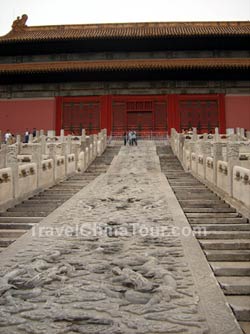
9 Dragon Marble Carving Ramp at Forbidden City.
Six Western Palaces of Forbidden City
Down the ramp I went, and continued my Forbidden Palace Tour on the west side. At this point, I entered the rear section of the forbidden palace which houses the Western Six Palaces. These palaces were the living quarters for the emperor and the emperess, and the six western palaces are:
- Palace of Everlasting Life (Yongshougong)
- Palace of Universal Happiness (Xianfugong)
- Palace for Gathering Elegance (Chuxiugong)
- Palace of the Queen Consort (Yikungong)
- Palace of Eternal Spring (Changchungong)
- Palace of Eternal Longevity (Shouangong)
Before you enter the 6 western palaces, you first come up to Yang Xing Dian (Hall of Mental Cultivation), which was the living quarters for the emperor, and also where he attended to much of his empire's politics.
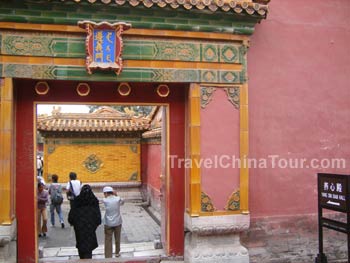
Entrance to the Yang Xin Dian (Hall of Mental Cultivation).
Hall of Mental Cultivation was constructed in 1537, and it is divided into two front and rear halls. Eight emperors of the Qing Dynasty, starting with Emperor Yongzheng, lived here. There is a throne for the emperor in the front hall, where he handled state affairs, and met officials. The rear hall is where the emperor slept.
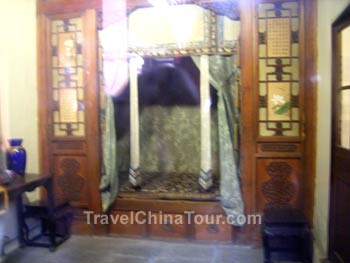
Photo of the bed in the rear hall of the Emperor's Hall.
Visitors are not allowed to enter the halls mentioned here, and must view from outside through glass windows - hence the quality of the above photo isn't that great, and you can see the glass reflection. This was taken of the bed inside the rear hall where the emperor slept.
Forbidden City's Imperial Garden
After finished touring the six western palaces, I came to the Imperial Garden of the Forbidden City, which was constructed in 1417 and covers 12,000 square meters. There is a pavilion at each of the four corners of the imperial garden symbolizing the four seasons. The east corner pavilion is the most famous named The Pavilion of Myriad Springs, and it is the symbol for spring.
One of the famous sites in the Imperial Garden is Dui Xiu Shan (Hill of Accumulated Elegance). It's an artificial hill made of rocks that's about 10 meters high, and on top of the hill is Yu Jing Ting (Pavillion of Imperial Scenery).
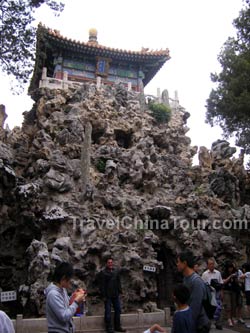
Photo of Dui Xiu Shan in the Imperial Garden.
As the Imperial Garden is located north (rear) of the Forbidden City, you can elect to exit through the rear gates, or continue on East to tour the Eastern palaces. I do recommend continuing east, since you'll get to see the famous Nine Dragon Wall Screen.
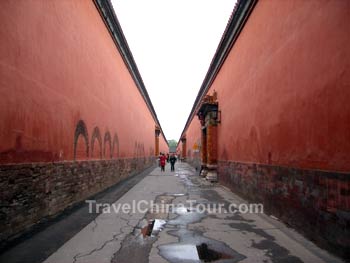
A long corridor going down the East Path in the Forbidden City.
Nine Dragon Screen Wall
Following the path as shown in the picture above, I came up to the Nine Dragon Screen Wall section. The Nine Dragon Wall Screen was constructed from 1771 to 1776. There are nine dragons carved on the wall that is 29.4 meters wide. A golden dragon is in the center and eight dragons in blue, white, purple, and yellow are placed on both sides. The center dragon was the symbol of the emperor.
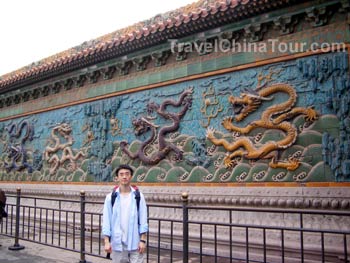
Nine Dragon Wall Screen at the Forbidden City.
Continue to next part. |